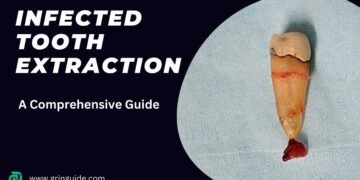Table of Contents
Introduction
A periapical abscess is a localized collection of pus that occurs at the tip of the root of a tooth. This type of abscess is typically the result of a bacterial infection that has spread from the tooth’s pulp, the innermost part of the tooth containing nerves and blood vessels. When bacteria invade the pulp, they can cause an infection that leads to the formation of an abscess. This condition is distinct from other types of dental abscesses, such as gum abscesses, which form in the gum tissue rather than at the root of a tooth.
The primary distinction between a periapical abscess and a gum abscess lies in their origins and locations. While a periapical abscess begins inside the tooth and extends to the root, a gum abscess, also known as a periodontal abscess, originates in the gums and is usually associated with periodontal disease. Both types of abscesses can be painful and require prompt attention, but the treatment approaches may vary depending on the type and severity of the abscess.
Early detection and treatment of a periapical abscess are crucial to prevent complications. If left untreated, the infection can spread to surrounding tissues, leading to more severe health issues such as cellulitis, osteomyelitis, or even sepsis. Symptoms of a periapical abscess may include severe toothache, sensitivity to hot or cold, swelling in the face or cheek, and fever. Timely intervention by a dental professional can help alleviate pain, eliminate the infection, and preserve the affected tooth.
Understanding the nature of periapical abscesses and recognizing the symptoms early can significantly improve treatment outcomes. Regular dental check-ups and good oral hygiene practices are essential preventive measures to minimize the risk of developing such infections. By staying informed and proactive, individuals can effectively manage their oral health and avoid the complications associated with periapical abscesses.
Common Symptoms of Periapical Abscesses
Periapical abscesses, a type of gum abscess, manifest through a variety of symptoms, often causing significant discomfort and prompting the need for prompt dental attention. One of the hallmark symptoms is a severe toothache, which can be persistent and throbbing. This pain often intensifies when pressure is applied to the affected tooth, such as during chewing, or even when lying down, which can exacerbate the discomfort. Sensitivity to hot and cold temperatures is another prevalent symptom, where consuming hot beverages or cold foods can trigger sharp, acute pain.
Swelling is a common physical sign associated with periapical abscesses. This can affect the face or cheek, leading to noticeable puffiness and tenderness in the area surrounding the infected tooth. In more severe cases, the swelling may extend to the jaw or neck. Accompanying the swelling, patients might also experience a fever, signaling that the body is fighting off an infection. This systemic response is an important indicator that the abscess is not just localized but is affecting the overall health of the individual.
The intensity of these symptoms can vary significantly from person to person. Some individuals may experience mild discomfort, while others might endure excruciating pain that interferes with daily activities. An important sign that professional dental intervention is necessary includes the presence of pus, a foul taste in the mouth, or an unpleasant odor, all of which suggest that the infection is progressing. Additionally, if the toothache becomes unbearable or if the swelling and fever persist or worsen, it is imperative to seek immediate dental care.
Overall, recognizing the symptoms of a periapical abscess early and understanding their potential severity can help in managing the condition effectively. Prompt diagnosis and treatment are crucial to prevent complications and ensure a swift recovery.
Diagnostic Tools: X-rays and Radiology
Dental X-rays and other radiological techniques play a crucial role in diagnosing periapical abscesses and gum abscesses. These imaging tools provide detailed insights that are essential for identifying the extent of the infection and formulating an effective treatment strategy.

When a patient presents with symptoms indicative of a periapical abscess, such as persistent toothache, swelling, or sensitivity, dental X-rays are often the first diagnostic tool employed. X-rays can reveal the presence of an abscess at the root of a tooth by highlighting any radiolucent areas, which indicate bone loss or other abnormalities. This imaging technique helps in determining the exact location and size of the abscess, which is critical for planning the appropriate intervention.
Advanced radiological techniques, such as Cone Beam Computed Tomography (CBCT), offer even more detailed imaging. CBCT provides three-dimensional views of the dental structures, allowing for a comprehensive assessment of the periapical region. This is particularly beneficial when the abscess is not easily visible on standard X-rays or when a more precise evaluation of the surrounding tissues is needed. The high-resolution images from CBCT can aid in identifying the full extent of the infection and any potential complications, such as the involvement of adjacent teeth or the sinus cavity.
In addition to X-rays and CBCT, other radiological methods, such as digital radiography, enhance diagnostic accuracy and patient experience. Digital radiography reduces radiation exposure and provides instant images, facilitating quicker diagnosis and treatment planning. These advanced imaging techniques are indispensable in the early detection and management of periapical abscesses, ensuring that patients receive timely and appropriate care.
Overall, the use of dental X-rays and radiology in diagnosing periapical abscesses and gum abscesses is integral to modern dental practice. These tools not only help in pinpointing the infection but also guide the dentist in selecting the most effective treatment approach, ultimately improving patient outcomes.
Treatment Options for Periapical Abscesses
Treating a periapical abscess requires a multi-faceted approach that focuses on eradicating the infection, relieving pain, and preserving the affected tooth whenever possible. One of the first lines of treatment usually involves the use of antibiotics. Antibiotics are prescribed to eliminate the bacterial infection causing the abscess. While antibiotics can help control the spread of infection, they are not a standalone cure. It is crucial that the source of the infection is addressed to prevent recurrence.
Root canal therapy is often considered the most effective treatment for a periapical abscess. During this procedure, a dentist or endodontist will remove the infected pulp from the interior of the tooth. The root canals are then cleaned, disinfected, and filled with a biocompatible material. This process not only removes the infection but also saves the tooth from extraction. Patients undergoing root canal therapy can expect some discomfort during and after the procedure, but this is typically manageable with over-the-counter pain medications and should subside within a few days.
In cases where the tooth is too severely damaged to be saved, extraction may be necessary. Tooth extraction involves removing the infected tooth entirely, which helps prevent the spread of infection to other parts of the mouth. Following extraction, patients may discuss options for tooth replacement, such as dental implants or bridges, with their dentist to restore functionality and aesthetics.
Other treatment methods may include incision and drainage. This procedure involves making a small cut in the gum to drain the pus from the abscess, providing immediate relief from pain and pressure. This is usually a temporary solution and is often followed by more definitive treatments like root canal therapy or extraction.
The recovery process from these treatments varies depending on the severity of the abscess and the chosen treatment method. Patients should follow their dentist’s aftercare instructions carefully, which may include maintaining good oral hygiene, taking prescribed medications, and attending follow-up appointments. Proper post-treatment care is essential to ensure complete healing and to prevent future occurrences of periapical abscesses or gum abscesses.
Drainage of Periapical Abscesses
Draining a periapical abscess is a crucial procedure aimed at alleviating pain and preventing the spread of infection. The necessity stems from the accumulation of pus in the infected area, which can cause significant discomfort and potential complications if left untreated. The primary goal is to remove the pus, reduce inflammation, and facilitate healing.
Several techniques can be employed for draining a periapical abscess. One common method is incision and drainage, where a small cut is made in the gum to allow the pus to escape. This procedure is typically performed under local anesthesia to minimize discomfort. Another technique involves root canal therapy, where the dentist drills into the affected tooth to drain the abscess from within, followed by cleaning and sealing the root canal system.
Patients undergoing drainage can expect a relatively straightforward procedure. During the process, local anesthesia is administered to numb the area, ensuring a pain-free experience. The dentist then makes an incision to release the pus. In cases where root canal therapy is necessary, the process might be slightly longer, involving multiple visits to fully clean and treat the tooth.
Pain management is a critical aspect of post-drainage care. Over-the-counter pain relievers such as ibuprofen or acetaminophen are commonly recommended. In some cases, antibiotics may be prescribed to combat any residual infection. Patients should follow their dentist’s instructions carefully, including taking medications as prescribed and maintaining good oral hygiene.
After the procedure, patients are advised to avoid strenuous activities and follow a soft food diet for a few days. Proper oral care, including gentle brushing and rinsing with a saline solution, can aid in the healing process. Regular follow-up appointments are essential to monitor recovery and address any potential complications.
Understanding the drainage process and adhering to post-procedural care can significantly enhance recovery and prevent future occurrences of periapical abscesses. Ensuring timely intervention and proper management is key to maintaining oral health and overall well-being.
Complications Arising from Untreated Abscesses
If left untreated, a periapical abscess can lead to several serious complications, underscoring the critical need for timely medical intervention. One of the primary concerns is the spread of infection. When an abscess is not addressed, the bacterial infection can extend beyond the tooth root to adjacent tissues, causing cellulitis. This can result in swelling, redness, and severe pain in the affected area, potentially escalating to a systemic infection.
Another significant issue is the formation of gum boils, also known as parulis. These are small, pus-filled swellings on the gum that arise when the infection spreads from the periapical area to the gum tissue. Gum boils are not only painful but can also contribute to further oral complications if not properly managed.
Untreated periapical abscesses can also lead to periodontal disease, a severe gum infection that damages the soft tissue and can destroy the bone supporting the teeth. This can result in tooth loss and other dental complications, significantly impacting oral health and overall well-being.
Beyond oral health, the ramifications of an untreated abscess can extend to other areas of the body. The infection has the potential to spread to the jawbone, leading to osteomyelitis, or even to the bloodstream, causing sepsis—a life-threatening condition that requires immediate medical attention. Additionally, there is a risk of developing a brain abscess if the infection spreads to the brain, which can have grave consequences.
These potential complications highlight the importance of seeking prompt dental care when symptoms of a periapical abscess arise. Early diagnosis and treatment are crucial in preventing the infection from spreading and causing more severe health issues. Therefore, maintaining regular dental check-ups and not ignoring the signs of a gum abscess can play a pivotal role in safeguarding one’s overall health.
Gum Swelling and Gum Boils: What They Indicate
Gum swelling and the occurrence of gum boils are often alarming symptoms that can indicate the presence of a periapical abscess. When an infection occurs at the root of a tooth, it can lead to the formation of a pus-filled cavity, causing notable swelling in the surrounding gum tissue. This swelling is a response to the body’s immune system fighting off the bacterial infection, and it can range from mild to severe, depending on the extent of the infection.
One of the initial signs of a periapical abscess is a noticeable gum swelling near the affected tooth. This can be accompanied by tenderness and pain, which may intensify when pressure is applied, such as while chewing or brushing. The swelling often indicates that the infection is progressing, and if left untreated, it can spread to other areas, potentially leading to more severe oral health complications.
Gum boils, or parulis, are another significant indicator of a periapical abscess. These small, pimple-like lesions on the gums are typically filled with pus and may occasionally burst, releasing the pus and providing temporary relief from pain. However, the underlying infection remains, and the boil is likely to reappear if the root cause is not addressed. The presence of gum boils suggests that the infection has progressed to a point where the body is attempting to drain the abscess on its own.
Both gum swelling and gum boils are symptomatic of underlying dental health issues, such as tooth decay, trauma to the tooth, or previous dental procedures that may have compromised the tooth’s integrity. These symptoms should not be ignored, as they indicate that the infection is advanced and requires prompt professional dental treatment. Addressing the root cause of the infection is crucial in preventing further complications and ensuring the preservation of oral health.
The Risks and Realities of Popping a Gum Abscess
Popping a gum abscess at home may seem like a quick fix, but it is fraught with significant risks and potential complications. A gum abscess, which is a localized collection of pus resulting from a bacterial infection, requires professional intervention to be managed safely and effectively. Attempting to lance or drain the abscess yourself can lead to several adverse outcomes.
One of the most immediate risks is exacerbating the infection. When you pop a gum abscess, you may inadvertently introduce new bacteria into the wound, worsening the condition. The abscess can proliferate, potentially leading to a more severe and widespread infection, including the risk of systemic infection or sepsis, which is life-threatening and requires urgent medical attention.
Additionally, improper drainage can result in the abscess not being fully emptied, causing the infection to persist and potentially spread to adjacent tissues, including the jawbone and other areas of the oral cavity. This can lead to more complicated dental issues, such as osteomyelitis (bone infection) or cellulitis (skin infection), both of which require extensive treatment.
Another significant concern is the pain and damage you might inflict on your gums and surrounding structures. Without the proper tools and sterilization techniques used by dental professionals, you risk causing further trauma to the affected area. This could result in prolonged healing times and additional complications, such as scarring or the development of further abscesses.
Instead of attempting to pop a gum abscess at home, it is crucial to seek safer alternatives. Over-the-counter pain relievers and saltwater rinses can help manage symptoms temporarily. However, the most effective and safest approach is to consult a dental professional. Dentists are equipped to properly diagnose and treat gum abscesses, using sterile instruments and appropriate techniques to ensure the infection is fully addressed. They may also prescribe antibiotics to help clear the infection and prevent its recurrence.
In conclusion, while it may be tempting to try and resolve a gum abscess on your own, the risks far outweigh the potential benefits. Professional dental care is essential for effectively managing and treating a gum abscess, ensuring not only the resolution of the infection but also the prevention of further health complications.
FAQs
How do you get rid of a periapical abscess?
Treating a periapical abscess typically involves draining the abscess and eliminating the infection. This may require a root canal procedure to remove the infected pulp or, in severe cases, tooth extraction. Antibiotics may also be prescribed to manage the infection. It’s crucial to seek prompt dental care to prevent complications.
What is the difference between a periodontal abscess and a periapical abscess?
While a periapical abscess originates from the tooth’s pulp, a periodontal abscess is an infection in the gums around the tooth. The main difference lies in their location: periapical abscesses form at the tooth’s root tip, whereas periodontal abscesses develop in the supporting bone and gum tissues. Treatment for a periodontal abscess often involves deep cleaning of the gum pockets and antibiotics.
How long does a periapical abscess last?
The duration of a periapical abscess can vary depending on the treatment approach and the individual’s overall health. Without treatment, the abscess may persist and lead to severe complications. Visually, a periapical abscess may appear as a swollen, red area on the gums, sometimes accompanied by a pus-filled bump. Early diagnosis and treatment are critical for effective management and recovery.
What does a periapical abscess look like?
A periapical abscess is a pocket of pus that forms at the tip of a tooth’s root due to a bacterial infection. This condition arises when bacteria invade the dental pulp, often following untreated cavities, dental trauma, or failed dental procedures. Symptoms can include severe toothache, sensitivity to hot and cold, and swelling in the face or jaw.











